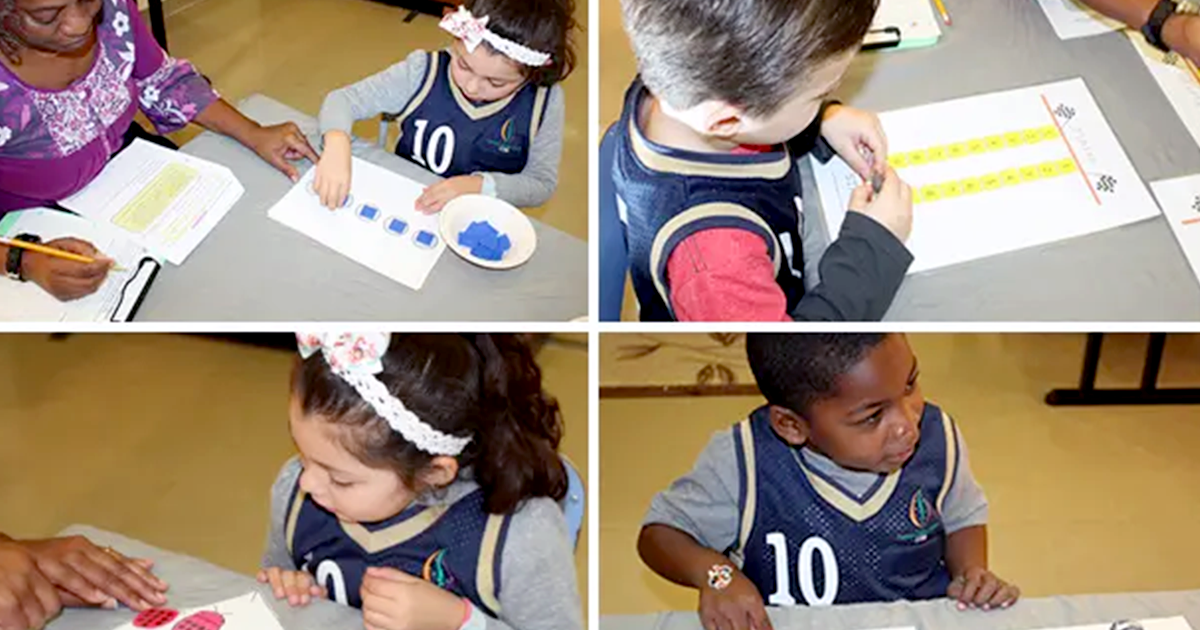Delivering High-Dosage and High-Quality Tutoring in Pre-K Math: A Q&A With Kylie Flynn and Alice Klein
Posted on

As the National Center for Education Statistics continues to release information about the amount of learning loss caused by the pandemic, many education leaders and districts are prioritizing tutoring programs to support students who have fallen behind and to address lost instructional time.
WestEd Senior Project Directors Kylie Flynn and Alice Klein lead a team that is successfully delivering high-dosage tutoring to more than 100 pre-K children in 28 classrooms in Sacramento, California.
The Pre-K Mathematics Tutorial Project (PMKT), funded by the Institute of Education Sciences (IES), is a WestEd program designed to identify and support pre-K children who are low-performing in math. This puts them at risk for mathematical difficulties when they enter elementary school. In a rigorous study, PKMT was the only Tier-2 math intervention for pre-K students that was shown to be effective; it provided high-dosage math tutoring to preschool children in addition to their general math curriculum. Academic Tier-2 interventions like PKMT are programs or strategies provided to students in addition to their general classroom curriculum.
In this Q&A, Flynn and Klein discuss the program’s history and impact on students, including key takeaways for districts considering implementing high-dosage tutoring programs to support pre-K children who are behind in their mathematical development.
When did the Pre-K Mathematics Tutorial (PKMT) project start and why?
Our prior research found that a subset of children in our randomized studies of Pre-K Mathematics, an evidenced-based math program for the general population of preschool children, did not appear to benefit from the systematic math instruction their teachers provided as part of the study. We reasoned that if these children were not given an opportunity to develop the crucial foundational math skills needed for kindergarten, they would likely fall further behind in their mathematical development and possibly be classified for special education.
The PKMT curriculum was designed to support children through hands-on, developmentally appropriate activities provided daily to pairs of children by trained tutors. The PKMT curriculum proved effective in a randomized study of over 500 pre-K children in two states conducted from 2012–2017. This current project, funded by the Institute of Education Sciences (IES) in June 2020, aims to determine whether the positive impacts found in the original study can be replicated.
The program is designed for students in need of additional support. Who are these students, and how do their experiences in the program impact their overall approach to mathematics?
The children receiving the tutoring comprise a diverse sample of children from low-income backgrounds attending state pre-K or Head Start programs. We screen all the 4-year-olds in a classroom at the beginning of the school year to determine who needs extra support in their math development.
The goal of the program is to provide eligible children with opportunities to engage in focused math activities with concrete objects to help them develop a broad foundation of informal mathematical knowledge. This foundation prepares them to learn the abstract formal math concepts taught in early elementary school.
How were the classrooms selected for this year’s program?
The SETA Head Start program in Sacramento helped us establish partnerships with state preschool programs in the Sacramento City Unified School District (USD) and San Juan USD. The project is taking place in all three of these programs. The programs were excited to participate, given the challenges they experienced because of the pandemic (e.g., staffing shortages, chronic absenteeism, and increased social–emotional needs among children).
Who are the program tutors, and what feedback are they getting from teachers, administrators, and parents?
Our tutors come from a variety of educational backgrounds, primarily early childhood education and psychology. Several are bilingual in Spanish and can provide tutoring to students who are predominantly Spanish speaking. The tutors communicate regularly with teachers and parents, including providing teachers with the tutored children’s performance summary data. This data helps preschool teachers in California complete their required Desired Results Developmental Profile for each child.
Administrators, teachers, and parents have expressed their appreciation for the work we are doing with the children. During a classroom observation, the site supervisor and teacher told the observer how much they appreciate their tutor, noting that she always has a positive attitude, and the kids just love her.
How do the children interact with the tutor and the math materials, and what strategies does the tutor use to engage them?
All the activities include hands-on materials for the children to interact with in a structured game-like way. The tutors present a new activity each week—the activities build on each other according to a developmental progression of difficulty. The tutors present each activity to pairs of children using a script to guide their presentation. This helps them support children’s learning consistently and provide developmental adjustments (e.g., providing an easier or harder problem, scaffolding to help children be successful) as needed.
What progress have the children made as a result of participating in the program?
The tutoring continues until early May, so we will know more after the post-assessment data is collected at the end of the school year. However, we see that the children are making clear progress on the tutoring activities. Many children could not count to five at the beginning of the school year. Now, most of them can count at least ten objects accurately using one-to-one correspondence and providing the cardinal value when they are done counting. Additionally, at the beginning of the year, children mastered few activities with many exposures but are now able to master more concepts with fewer exposures.
Why is high-dosage tutoring used in the program, and how does it impact student learning and academic achievement?
Research shows that children who are underserved and struggle to learn math need multiple exposures, clear feedback, and opportunities for review to master some math concepts. PKMT satisfies each of these Tier-2 program criteria by providing opportunities to practice, scripted scaffolding, and frequent review. We find that many of the children demonstrate an uneven performance initially and require several opportunities to practice skills before they are integrated and mastered.
What are some key takeaways from this program and considerations for education leaders in other states working to implement high-dosage tutoring to accelerate student learning and help students in need of additional support?
The PKMT project is not complete yet, but we know from the original study that high-dosage tutoring is effective in two states with different types of math instruction in their classrooms.
One of the largest barriers to tutoring, particularly in early childhood programs, is staffing. Unlike K–12 schools, most early childhood programs do not have interventionists or resource specialists who can provide high-dosage tutoring. That is why we plan to train teachers and instructional assistants next year to provide PKMT instruction to pairs of children in the classroom. One of our primary research questions is whether PKMT is as effective when implemented in the classroom by teaching staff as it is when implemented by tutors outside of the classroom. So, please stay tuned for more information.
How can other California school districts get involved?
They can contact Kylie at kylie.flynn@wested.org. There will be opportunities for teachers to be trained to use PKMT in the coming school year (2023–24).

 Kylie Flynn (left) and Alice Klein (right) direct randomized controlled trials funded by the U.S. Department of Education. Flynn’s interests focus on improving education outcomes for students who have been underserved through the testing of educational interventions. She serves as an Area Director of Research and Evaluation within WestEd. Klein’s research focuses on educational interventions to enhance the mathematical knowledge of preschool and kindergarten children who have been underserved and to prepare them for standards-based math instruction in elementary school. She is the lead author of the PKMT curriculum and a Senior Research Associate on WestEd’s Mathematics content area team.
Kylie Flynn (left) and Alice Klein (right) direct randomized controlled trials funded by the U.S. Department of Education. Flynn’s interests focus on improving education outcomes for students who have been underserved through the testing of educational interventions. She serves as an Area Director of Research and Evaluation within WestEd. Klein’s research focuses on educational interventions to enhance the mathematical knowledge of preschool and kindergarten children who have been underserved and to prepare them for standards-based math instruction in elementary school. She is the lead author of the PKMT curriculum and a Senior Research Associate on WestEd’s Mathematics content area team.
